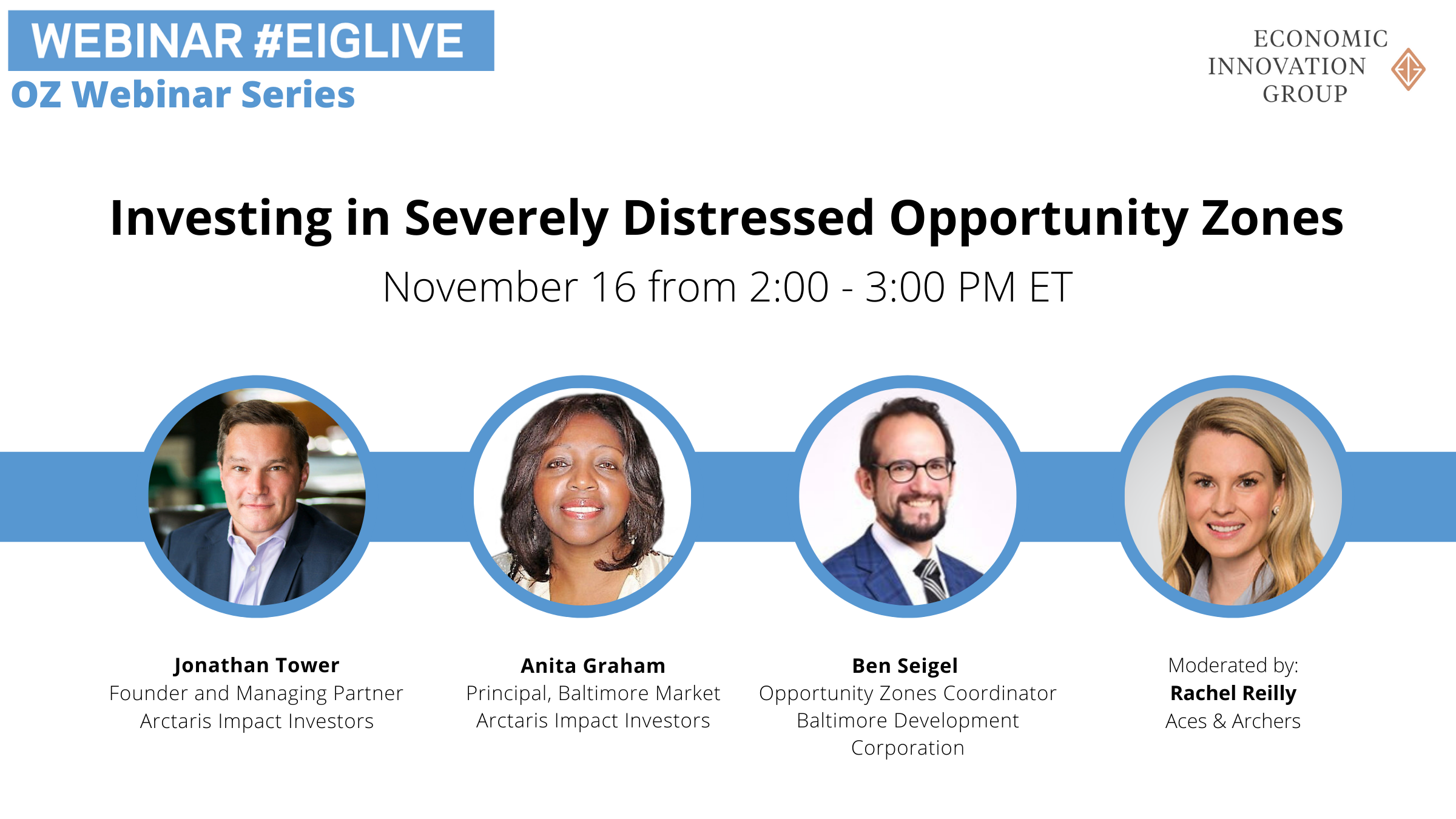On November 16, the Economic Innovation Group (EIG) hosted a webinar to discuss investment activity occurring in the Opportunity Zones (OZ) where capital is most needed. Guest speakers shared details on two recent OZ investments that are illustrative of broader efforts to direct capital to distressed communities.
View presentation slides, a recording of the webinar, and EIG’s key takeaways for more information.
Key Takeaways
Prior to guest speaker presentations, EIG’s Director of Research Kenan Fikri provided an overview of the Government Accountability Office’s (GAO) report on OZs released on November 8. Fikri shared key findings from the GAO report, which are noted below and expanded upon in EIG’s analysis of the study.
- The OZ incentive supported at least $29 billion in new equity investment throughout the country through 2019.
- The 2018 designation process clearly succeeded in targeting high-need communities nationwide.
- States overwhelmingly have a positive or “wait and see” view of the policy, with positive responses outnumbering outright negative by a 20 to 1 margin.
- Firms surveyed indicate that, for the most part, the OZ incentive is driving investment that would not have otherwise occurred within targeted communities.
- The IRS needs to step up its efforts to evaluate and address potential compliance challenges.
Rachel Reilly from Aces & Archers highlighted that GAO found that the OZ policy is 1) likely expanding the amount of capital available for community investment by bringing new investors into the fold, 2) accelerating project timelines, 3) delivering capital needed to close financing gaps, 4) allowing developers to offer greater shares of planned housing units at more affordable rates, and 5) likely redirecting capital flows into designated communities. Reilly also noted that the investments featured during the webinar occurred in zip codes experiencing the highest levels of distress, according to EIG’s Distressed Communities Index (DCI).
Jonathan Tower and Anita Graham from Arctaris Impact Investors (Arctaris) spoke about their efforts to partner with local governments and foundations to structure OZ programs in cities throughout the nation. Their competitive Request for Proposals process garnered responses from community leaders in 25 states, demonstrating the widespread need for community-aligned investment capital.
To illustrate these local partnerships, Tower and Graham shared details about Arctaris’ OZ programs in Pittsburgh, PA and Baltimore, MD. The $20 million Pittsburgh program is being implemented in partnership with the R.K. Mellon Foundation, and is tailored to drive OZ investment in local priorities: affordable and workforce housing, renewable energy, broadband expansion, and businesses that create living-wage jobs.
Arctaris representatives then provided an overview of their recent OZ investment in S&K Holdings — a minority-owned healthcare company focused on providing healthcare services to elderly and disabled Medicaid patients. S&K Holding will use this investment to expand its geographic footprint, create 600 living-wage jobs, and centralize operations in Pittsburgh’s Hill District, which ranks 97.6 out of 100 in terms of its level of distress, per the DCI.
Ben Seigel from the Baltimore Development Corporation then discussed his role as the Opportunity Zones Coordinator for Baltimore, MD and provided an overview of investment activity occurring throughout the city.
Seigel shared that Baltimore’s OZs are concentrated in three neighborhood typologies – Commerce-Driven, Anchor-Driven, and Impact Investment neighborhoods, and provided examples of OZ investment that has occurred in those communities.
Seigel then shared details about two projects located in Impact Investment Neighborhoods that received OZ investment— Penn North Mixed-use (PNM) project and the Hoen Building. PNM, which broke ground during the week of November 15th, will transform abandoned row homes into “zero-energy” affordable housing and storefronts. This is occurring in the Penn North neighborhood, which ranks 95.7 out of 100 in terms of its level of distress per the DCI.
Resources Discussed
- EIG’s updated OZ fact sheets
- Webinar recap: Designing Opportunity Zones Initiatives the Benefit Underserved Residents (October 2021)
- Opportunity Zones Coalition’s Policy Recommendations Letter (March 2021)
Visit EIG’s OZ Resources webpage for additional information including deal profiles, mapped activity, and recordings of previous webinars.






